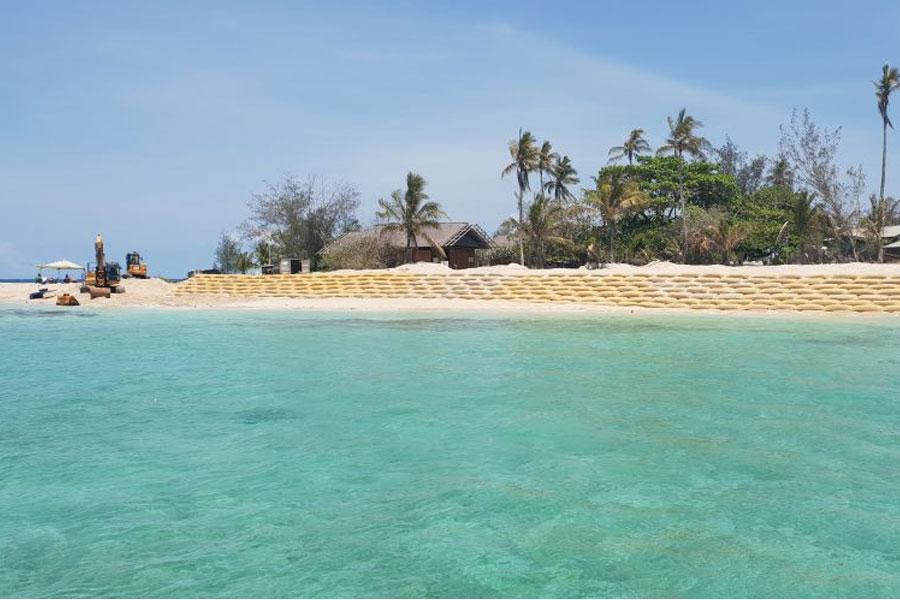How geosynthetic sand containers are slowing erosion and protecting communities from storm surges
The challenges faced by island communities
While most mainland Australians are familiar with the present and ongoing risks of climate change, for the people who live and work in the Torres Strait Islands off the coast of far North Queensland, climate change is an immediate and ongoing challenge.
Torres Strait Island communities are accustomed to living at the interface of the ocean and land and are all too familiar with the challenges this presents.
Over the previous few decades, as the climate has begun to change rapidly, island communities have witnessed some big changes to their environment that pose a serious threat to their future. The Torres Strait Island people are being challenged by more frequent and destructive environmental activity, such as rising sea levels combined with storm surges.
Events such as these cause accelerated erosion and increase the risk of inundation. For settlements and infrastructure, this is likely to result in damage to and loss of homes and businesses. For ecosystems, rising sea levels are likely to lead to loss of habitat and salinisation of soils. This in turn alters the distribution of plants and animals and affects the availability of freshwater.
What is the solution to protecting people, infrastructure and culture?
The Torres Strait Islands are facing a complex array of issues, from rising sea levels and coastal erosion through to loss of cultural heritage, wildlife habitats and property.
Low lying coastal communities are already becoming climate refugees, displaced by rising seas and more frequent violent storms.
Of course, geosynthetics cannot solve all these issues, but they are able to address at least one of the immediate risks: loss of the foreshore.
Geosynthetic solutions such as Georock® Geotextile Sand Containers (GSC) are incredibly effective at encapsulating available sand in a very heavy grade geotextile bag that resists the effects of tidal wash and wave action.
This allows for the construction of a geosynthetic seawall: an efficient, climate-friendly, cost-effective method of creating a ‘last line of defence’ against tidal surges and waves.

How geosynthetic seawalls are constructed
The construction methodology for Geotextile Sand Containers is quite straightforward – all that is needed is a couple of excavators fitted with “U” cradles and filling frames, and a method of compacting the sand in the bag while it is being filled.
The process begins with a heavyweight geotextile being placed on the foundation soil to prevent seawater scouring in behind the seawall and destabilising the finished wall.
Once the fabric has been laid, the empty Georock® bags are placed in a mobile U cradle/filling frame and an excavator places stockpiled sand into the bag. The cradle provides the necessary support to prevent the bag from losing shape while being filled and compacted.
Following the filling and compaction, the bag is sewn closed and transported, still in the ”U” frame, to its final location in the wall as per the design. These types of seawalls are constructed using similar techniques to laying house bricks; using a stretcher bond or header bond method depending on the design.
The design of the wall is critical to achieving the maximum benefit of the Geotextile Sand Containers and is normally undertaken by a very experienced Coastal Engineer who must consider many factors before arriving at the final design.
A strong, natural, long-lasting defence
Once the seawall is constructed, extra sand (if available) can be reinstated in front of the wall to create a more natural beach that may also be stabilised with natural vegetation.
Under the best prevailing weather conditions, sand can also naturally be deposited on and in front of the wall. For this situation, the GSC seawall would only be exposed during more extreme weather events. In a lot of scenarios, the addition of more sand may not be economically possible, or in some cases, it has simply been carried away by wave and wind actions. This is especially true in the Torres Strait where additional materials must be barged to the site at great cost.
For site conditions where the bags are exposed, this is accommodated in the manufacture of the Georock bag by using a thick layer of highly UV stabilised geotextile in combination with an anti-vandal layer of thick open structured geotextile. The open nature of the anti-vandal layer allows sand to become trapped throughout the fabric which improves the long-term UV performance of the Georock® bag. This manufacturing process allows our sand containers to last for the life of the structure while fully exposed.
An additional benefit is that this very tough anti-vandal layer provides significant resistance to damage from human activity, resisting cuts from fishing knives for example.
For this project, Global Synthetics and our recommended installation partner worked with a local Indigenous construction team to build the seawall, which has since been hit by multiple storm events. The attached images show sand that has been naturally deposited on the wall after storms, illustrating how a well designed and constructed Georock® wall effectively protects the shoreline and coastal vegetation.

Design an environmentally sound solution with Global Synthetics
The use of strong, lightweight and effective products such as geosynthetic sand containers provides a low-carbon alternative to expensive drilling, blasting, processing and hauling our dwindling raw materials.
If you would like to know more about our Georock® Sand Containers as a solution for your next project, get in touch with our friendly team at info@globalsynthetics.com.au

